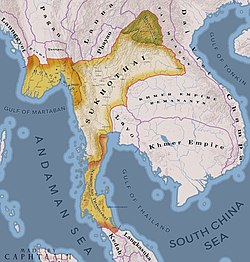
Back মুয়াং সুয়া Bengali/Bangla មឿងស្វា Cambodian ເມືອງຊວາ Laothian Muang Sua Lithuanian Sawa (stad) Dutch Muang Sua Serbo-Croatian เมืองชวา Thai 孟蘇瓦 Chinese
This article needs additional citations for verification. (August 2019) |
Muang Sua ເມືອງຊວາ | |||||||||||||
|---|---|---|---|---|---|---|---|---|---|---|---|---|---|
| 698–1353 | |||||||||||||
 Muang Sua as a vassal to Sukhothai in 1293. | |||||||||||||
| Capital | Muang Sua | ||||||||||||
| Common languages | Lao, Tai | ||||||||||||
| Religion | Buddhism | ||||||||||||
| Government | Monarchy | ||||||||||||
| Prince | |||||||||||||
• 698-780 | Khun Lo | ||||||||||||
• 780-??? | Khun Sung | ||||||||||||
| Historical era | Medieval era | ||||||||||||
• Creation of Muang Sua | 698 | ||||||||||||
• Khmer vassal | 950 | ||||||||||||
• Lan Xang founded | 1353 | ||||||||||||
| Currency | Barter | ||||||||||||
| |||||||||||||
| Today part of | Laos | ||||||||||||
Muang Sua (Lao: ເມືອງຊວາ, pronounced [mɯ́aŋ súa]) was the name of Luang Phrabang following its conquest in 698 by a Tai/Lao prince, Khun Lo, who seized his opportunity when the king of Nanzhao was engaged elsewhere. Khun Lo had been awarded the town by his father, Khun Borom, who is associated with the Lao legend of the creation of the world, which the Lao share with the Shan and other peoples of the region. Khun Lo established a dynasty whose fifteen rulers reigned over an independent Muang Sua for the better part of a century.